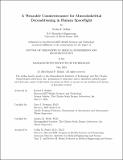A Wearable Countermeasure for Musculoskeletal Deconditioning in Human Spaceflight
Author(s)
Bellisle, Rachel F.
DownloadThesis PDF (42.32Mb)
Advisor
Newman, Dava J.
Webb, Andrea K.
Terms of use
Metadata
Show full item recordAbstract
In the reduced gravity experienced during human spaceflight, the human body no longer experiences the constant loading provided by Earth’s gravity. Muscles atrophy due to disuse, the spine elongates, which may cause back pain and discomfort, and sensorimotor changes lead to impaired posture and locomotion. The Gravity Loading Countermeasure Skinsuit (GLCS or Skinsuit) is a musculoskeletal deconditioning countermeasure for spaceflight, consisting of a skin-tight garment that applies a vertical load from the shoulders to the feet. The suit aims to mitigate musculoskeletal deconditioning (potentially including spine, muscle, and sensorimotor) during exposure to microgravity by simulating some of the effects of Earth’s gravity (1G). This wearable system is intended to support human health and astronaut performance during future missions to the moon and Mars (where space for large exercise equipment may be unavailable) and to further mitigate microgravity-induced effects in current missions on the International Space Station (ISS). The high-level objectives of this research are 1) to further prepare the GLCS for operational use in human spaceflight and 2) to improve our understanding of GLCS loading and its effects on the musculoskeletal and sensorimotor systems.
In this thesis, the next-generation versions of the GLCS (the Mk-7 and Mk-8 GLCS) were fabricated, and a proof-of-concept instrumented GLCS was developed with integrated fabric strain sensing capabilities. Next, the loading functions (insole load, shoulder load, skin pressure, and fabric strain) and subjective user experience (discomfort, mobility, exertion, and dyspnea) in the GLCS were characterized in six participants. Subjective user experience was additionally measured in one participant in low-Earth orbit on the ISS. Results provide a characterization of GLCS experimental loads in static and dynamic body positions and indicate that the GLCS has sufficient comfort for 60 to 90 minutes of wear during resistance exercise.
Human participant studies in 1G, partial gravity analogs, and the ISS were used to investigate the effects of the GLCS on neuromuscular activity (surface EMG) and sensorimotor function (proprioception and functional performance). Statistically significant differences in metrics of EMG amplitude were observed between suited and unsuited conditions in some muscles during upright standing, hip external rotation, hip extension, and knee flexion, with additional non-significant trends seen in other activities. These results aim to guide the development of exercise procedures for the GLCS countermeasure system and indicate that the GLCS may be able to contribute to the mitigation of muscle atrophy. In sensorimotor tests, the GLCS produced a non-significant decrease in ankle inversion proprioception compared to unsuited conditions, and further investigation is needed.
This thesis investigated the fabrication of the GLCS, the loading function, the user experience, the impacts on two physiological targets (muscle activity and sensorimotor function), and the intersection of these aspects. The results contribute to the development of the GLCS as a proposed musculoskeletal countermeasure for future missions to low-Earth orbit, the moon, or Mars, and support the goal of the GLCS to maintain the safety, health, and performance of astronauts, ensuring that they can complete mission-critical tasks in flight and return safely to Earth.
Date issued
2024-05Department
Harvard-MIT Program in Health Sciences and TechnologyPublisher
Massachusetts Institute of Technology